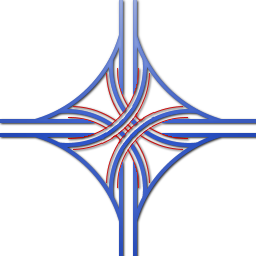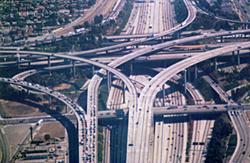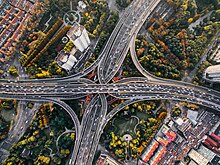Stack interchange

The Four Level Interchange of Arroyo Seco Parkway and Highway 101, looking northeast, in Los Angeles, California. It was the first stacked interchange in the world.
A stack interchange, or colloquially butterfly junction, is a particular, free-flowing type of designs for interchanges, meaning grade-separated road junctions. It is referred to as a directional interchange in the American Association of State Highway and Transportation Officials Policy on Geometric Design of Highways and Streets.[1]
In countries where one drives on the right, left turns are handled by semi-directional flyovers or under ramps. Vehicles first exit the main carriageway to the right, then complete the turn via a ramp that crosses both highways, eventually merging with the traffic turning right from the opposite side of the interchange. A stack interchange therefore has two pairs of left-turning ramps, which may be "stacked" in various configurations above or below the two interchanging highways. In countries where one drives on the left, the appearance of the junction is topologically identical, but traffic flows are reversed.
Stacks eliminate the problems of weaving and have the highest vehicle capacity among different types of four-way interchanges. However, they require considerable and expensive construction work for their flyover ramps, as well as having a larger footprint. Stack interchanges are also widely considered to be an eyesore among residents of homes near existing or proposed interchanges, leading to considerable NIMBY opposition.
Contents
1 Four-level stack
1.1 Examples
1.1.1 Europe
1.1.2 North America
1.1.3 Southern Hemisphere
2 Five-level stack
2.1 Texas-style stack
2.2 Other five-level stacks
3 Six-level stack
4 See also
5 References
6 External links
Four-level stack

Four-level stack
The four-level stack (or simply four-stack) has one major road crossing another on a bridge, with connector roads crossing on two further levels. This type of interchange does not usually permit U-turns. The four-level stack creates two "inverse" dual-carriageways—the turn ramps crossing the middle section have traffic driving on the opposite side of oncoming traffic to usual (see diagram for clarity).
Examples
Europe
In the United Kingdom there are three four-level stacks: at the junction of the M4 and M25 near Heathrow Airport in London, at the junction of the M23 and M25 to the south of London, and at the junction of the M4 and M5 near Bristol (the Almondsbury Interchange). The M4/M25 junction is particularly unusual as it also has a railway line bisecting it at its lowest level. The M4/M25 junction is slightly offset so there is no point where all four levels are directly above each other. M25 (a north–south road at this junction) is offset to the east by approximately 60 metres (200 ft). The junction of the A19 and A66 in Teesside uses a three-level variant, with a 270-degree loop allowing southbound A19 traffic to exit to the westbound A66.
In the Netherlands there is currently one four-level stack interchange: the Prins Clausplein near The Hague. It forms the junction of the A4 and A12.
North America

Highway Interchange between Dolphin Expressway and Palmetto Expressway (Dolphin–Palmetto Interchange) in Greater Miami, Florida, United States
The first stack interchange was the Four Level Interchange (renamed the Bill Keene Memorial Interchange), built in Los Angeles, California, and completed in 1949, at the junction of US Route 101 (US 101)and State Route 110 (SR 110).[2] Since then, the California Department of Transportation (Caltrans) has built eight more four-level stacks throughout the state of California, as well as a larger number of three-level stack/cloverleaf hybrids (where the least-used left-turning ramp is built as a cloverleaf-like 270-degree loop).

The partially used stack interchange over I‑84. CT‑9 traffic can be seen using the flyover to access westbound I‑84.
The first four-level stack interchange in Texas was built in Fort Worth at the intersection of Interstate 35W (I-35W) and I-30 (originally I-20) near downtown. This interchange, finished in 1958, was known as "The Pretzel" or the "Mixmaster" by locals. The original contract cost was $1,220,000.[3] Improvements to the old Mixmaster over the past 60 years include an upgrade to a Texas-style five-level stack exchange (see below).
One of the first four-level stack interchanges in the northeastern United States was constructed in the late 1960s over I-84 in Farmington, Connecticut, for the controversial I-291 beltway around the city of Hartford. Most of the I‑291 beltway was later cancelled, and the sprawling stack lay dormant for almost 25 years. In 1992 the extension of Connecticut Route 9 to I-84 used the I‑291 right-of-way and some sections of the abandoned interchange. Several ramps still remain unused, including abandoned roadbed for I-291 both north and south of the complex.
Four-level stacks are used for the interchanges between:
I-77 and I-485 in Charlotte, North Carolina
I-65 and I-440 in Nashville, Tennessee
I-90 and I-405 in Bellevue, Washington
I‑110 and US 61/US 190 in Louisiana
I-75 and I-696 near Detroit, Michigan
I-69 and I-475 in Flint, Michigan.
I‑70/I‑270 and I‑270/I‑64 St. Louis, Missouri
- The Marquette Interchange of I-794, I-94, and I-43 in Milwaukee, Wisconsin
Another well-known stack interchange lies west of Baltimore, Maryland, serving as the junction between I-695 and I-70. It was originally built for a planned extension of I‑70 into the city, but because of heavy opposition, I‑70 ends at a park and ride 3 miles (4.8 km) east. As a result, the road east of I‑695 sees very little traffic compared to the high volumes to and from the west.
Another four-level stack interchange in the Baltimore area is located at the northeastern junction between I-695 and I-95. The stack was built as part of a massive I-95 reconstruction project that includes high-occupancy toll lanes (HOT lanes), designed to relieve congestion between Baltimore and its northeastern suburbs.
In Lone Tree, Colorado, there is a four-level stack serving I-25, the eastern end of C-470 and the southern end of E-470. In Thornton, Colorado, there is another stack serving I-25 and E-470 at its northern end as it continues west as the Northwest Parkway.
Although it planned to build many four-level stack interchanges, Canada has only one true four-level stack interchange, between Highway 400 and Highway 407 in Ontario. Planned four-level stacks at Highway 407 and Highway 410, and Highway 407 and Highway 404 were reduced to three-level interchanges, with loop ramps instead of a fourth level of ramps. The interchange between Highway 401, Highway 403, and Highway 410 is almost a full four-level stack, with a loop ramp planned to be added in the northeast quadrant which would make it a four-way interchange.[4][5]
Southern Hemisphere
The Light Horse Interchange at the junction of the M4 and M7 is a four-level stack interchange in Sydney, New South Wales, Australia. Opened in late 2005, it is the largest in the Southern Hemisphere.
The EB Cloete Interchange just outside Durban, South Africa, is another four-level stack interchange. The N3 is the busiest highway in South Africa and a very busy truck route. Because Johannesburg is not located near a body of water, most of the city's exports travel through the Port of Durban. The N2 connects Cape Town with Durban and serves the South African cities of Port Elizabeth, Plettenberg Bay, and Margate, and the iSimangaliso Wetland Park. Two busy roads intersect at the junction. A four-level stack interchange was chosen to serve the high volumes of traffic.
Five-level stack
Texas-style stack

The High Five Interchange in Dallas, Texas, United States, is a five-level interchange.
In Texas, many stacks contain five levels. They usually have the same configuration as four-level stacks, but frontage roads add a fifth level. The frontage roads usually intersect with traffic lights and are similar to a grid of nearby one-way streets. A common setup is for one mainline to go below grade and another to go above grade. The intersection of the frontage roads is typically at grade or close to it. Two pairs of left-turn connectors are built above these.
The Dallas-Fort Worth Metroplex has several five-level stacks, most notably the High Five Interchange between US 75 and I-635; completed in 2005 and currently the tallest interchange in the world.[6] Others can be found at the interchanges between State Highway 121 (SH 121) and the Dallas North Tollway, SH 121 and I-35E/US 77, I-30 and I-35W, I-30 and President George Bush Turnpike and others which are technically five levels but do not fit under a Texas-style stack configuration (i.e. the extra level being located away from the central stack or existing in only one direction).
The Houston area has seven five-level stack interchanges along Beltway 8: at I-10 east and west of downtown, I-69 northeast and southwest of downtown, I-45 north and south of downtown, and US 290 in the beltway's northwest quadrant.[7] The newly reconstructed interchange of I-610 and I-69, with the new I‑610 northbound feeder road built underground and the new I-610 southbound feeder road overpass, is also a five-level stack interchange.[8]
Though not a Texas-style stack in the above sense, an unusual stack is nonetheless found in Houston that features more than four levels of traffic but whose fifth level exists in only one direction. In 2011, the previously four-level stack interchange between I-610 and I-10 on the city's east side gained a new (though long-planned)[9] level of complexity with the opening of four ramps connecting the new US 90 (Crosby Freeway) to the east, featuring direct movements for the new freeway to and from the southeast quadrant of I-610, to westbound I-10, and from eastbound I-10. It is the latter ramp which gives the interchange the fifth level, as US 90 to I-10 westbound merges onto I-10 before crossing I-610. (None of the frontage roads for these highways cross the interchange itself, and thus do not factor into the complexity of the stack.)[10]
More than 40 bridges make up the five-level stack interchange known as the Big I between I-40 and I-25 in Albuquerque, New Mexico.
China is also home to many Texas-style stack interchanges. For example the Nanjing's Yingtian Street Elevated has one each where it intersects the Inner Ring Road twice.
Other five-level stacks

The Judge Harry Pregerson Interchange in Los Angeles, California, United States.
Sometimes a fifth level is added for HOV connectors. An example of this exists in Los Angeles, California, at the Judge Harry Pregerson Interchange. The connector from HOV southbound 110 to HOV westbound 105 can be at the same level as the connector from mixed eastbound 105 to mixed northbound 110, but the connector from HOV southbound 110 to HOV eastbound 105 needs to be higher level, since it crosses over the former connector.
Another case is where connection to nearby arterials suggests that another level may be useful, thus making the interchange more complicated but easier to use. In the Atlanta area, a side ramp forms the fifth level of the Tom Moreland Interchange, colloquially known as Spaghetti Junction, found in DeKalb County, Georgia.
Six-level stack

Yan'an East Road Interchange, a six-level urban stack interchange in Puxi, Shanghai, China (Nanbei Elevated Road and Yan'an Elevated Road)
There is a six-level stack on the Yan'an East Road Interchange (Chinese: 延安东路立交) in Puxi, Shanghai, with no dedicated HOV/bus/truck lanes. It is six-level stack because it is formed by two elevated highways, Nanbei Elevated Road and Yan'an Elevated Road with service roads and a footbridge underneath. The centrally located interchange has a central pillar known as the Nine-Dragon Pillar (Chinese: 九龙柱). The story is that after several construction accidents, a monk suggested the nine-dragon be welcomed with a bas relief sculpture depicting the dragon.[citation needed]
An unusual six-level stack is located at the junction between Interstate 35E and I-635 in Dallas, Texas, and does not contain any service or frontage roads. The interchange features two levels of highway with the top three levels consisting of direct connection ramps and HOV connectors. A single ramp leading from I-635 westbound to I-35E southbound weaves underneath the I-635 eastbound bridge, making the interchange six levels.[11]
The interchange between I-35E and the Sam Rayburn Tollway in Lewisville, Texas, although similar in design to five-level stacks elsewhere in Texas, also qualifies as a six-level stack, since the ramp connecting the eastbound Sam Rayburn Tollway with northbound I-35E goes over the fifth-level ramps connecting I-35E in both directions with the Sam Rayburn Tollway. The ramp connecting the westbound Sam Rayburn Tollway with southbound I-35E is on the fourth level of the interchange, going under the fifth-level ramps connecting both directions of I-35E with the Sam Rayburn Tollway[12].

Yan'an East Road Interchange, seen from a pedestrian's perspective
See also
- List of road interchanges in the United States
References
^ American Association of State Highway and Transportation Officials (2011). A Policy on Geometric Design of Highways and Streets. Washington, DC: American Association of State Highway and Transportation Officials. pp. 10–53. ISBN 978-1-56051-508-1..mw-parser-output cite.citation{font-style:inherit}.mw-parser-output q{quotes:"""""""'""'"}.mw-parser-output code.cs1-code{color:inherit;background:inherit;border:inherit;padding:inherit}.mw-parser-output .cs1-lock-free a{background:url("//upload.wikimedia.org/wikipedia/commons/thumb/6/65/Lock-green.svg/9px-Lock-green.svg.png")no-repeat;background-position:right .1em center}.mw-parser-output .cs1-lock-limited a,.mw-parser-output .cs1-lock-registration a{background:url("//upload.wikimedia.org/wikipedia/commons/thumb/d/d6/Lock-gray-alt-2.svg/9px-Lock-gray-alt-2.svg.png")no-repeat;background-position:right .1em center}.mw-parser-output .cs1-lock-subscription a{background:url("//upload.wikimedia.org/wikipedia/commons/thumb/a/aa/Lock-red-alt-2.svg/9px-Lock-red-alt-2.svg.png")no-repeat;background-position:right .1em center}.mw-parser-output .cs1-subscription,.mw-parser-output .cs1-registration{color:#555}.mw-parser-output .cs1-subscription span,.mw-parser-output .cs1-registration span{border-bottom:1px dotted;cursor:help}.mw-parser-output .cs1-hidden-error{display:none;font-size:100%}.mw-parser-output .cs1-visible-error{font-size:100%}.mw-parser-output .cs1-subscription,.mw-parser-output .cs1-registration,.mw-parser-output .cs1-format{font-size:95%}.mw-parser-output .cs1-kern-left,.mw-parser-output .cs1-kern-wl-left{padding-left:0.2em}.mw-parser-output .cs1-kern-right,.mw-parser-output .cs1-kern-wl-right{padding-right:0.2em}
^ Four Level interchange-Los Angeles-Orange County Frwys[permanent dead link]
^ Interstate 35W, Fort Worth
^ "Design and Construction Report - Highway 401 Widening" (PDF).
^ "NOTICE OF SUBMISSION DESIGN AND CONSTRUCTION REPORT" (PDF).
^ "High Five Interchange, Dallas - Texas" (PDF). Chryso. Archived from the original (PDF) on April 26, 2012.
^ TexasFreeway > Houston > Photo Gallery > Beltway 8 Photos
^ Google (November 19, 2006). "Interstate 610 at U.S. 59 in Houston, Texas" (Map). Google Maps. Google. Retrieved November 19, 2006.
^ "TexasFreeway > Houston > Future Freeway > Future section of US 90, the Northeast/Crosby Freeway". TexasFreeway.com. Retrieved October 16, 2011.
^ Google (October 16, 2011). "East Fwy at North Loop" (Map). Google Maps. Google. Retrieved October 16, 2011.
^ "Phase 2 Entrance and Exit Points | LBJ TEXpress Lanes". www.lbjtexpress.com. Retrieved January 11, 2016.
^ "Renderings | The 35Express Project". www.35express.org. Retrieved October 20, 2017.
External links
| Wikimedia Commons has media related to Stack interchanges. |
Satellite image of Nanbei Elevated Road and Yanan Elevated Road 6-level interchange in Shanghai, China.
Satellite image of Interstate 105 and Interstate 110 5-level interchange in Los Angeles.
Satellite image of Interstate 95 and Interstate 695 4-level interchange near Baltimore, MD.

Comments
Post a Comment